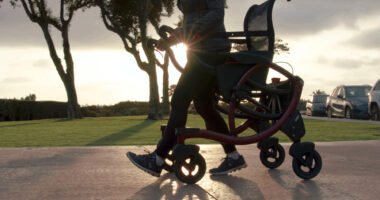I’m hopeful we’re starting a new chapter in the world of mobility aids
Developments in assistive technology have me excited about the future
Written by |

I remember the first time I saw the Zeen. A fellow Charcot-Marie-Tooth (CMT) patient had posted a video and some pictures of it on social media. From their posts, it was clear that this device was similar to scooters, wheelchairs, and rollators, yet I’d never seen a mobility aid that felt so new and different.
I believe the Zeen represents an important evolution in mobility devices. Many require users to either sit or hunch over, but the Zeen supports users in both seated and fully upright positions, and they’re able to transition between the two as needed. As a result, people are able to move around more naturally and ambulate as much as possible, preventing muscles from atrophying due to disuse. And the device doesn’t even need to be charged or plugged in.

A person uses a Zeen. (Courtesy of Zeen)
Seeing videos of the Zeen in action reminded me of watching mecha anime as a kid. The way the device transitions from seated to upright walking mode evoked memories of the robot transformations that amazed me growing up.
However, unlike transforming space robots in anime shows, the Zeen is real and tangible. It’s something people can buy, interact with, and work to improve. And that makes me eager to see what’s next.
Why this kind of development matters
My CMT symptoms haven’t yet progressed to a point where I need to rely on a mobility device like the Zeen. However, I’ll likely need an aid eventually, and I have friends and loved ones who benefit from similar devices now, so it makes sense why I’d be excited about such a development. But this should matter to everyone — not just the disability community.
According to Inclusive City Maker, 1 in 7 U.S. adults has a physical impairment that affects their mobility. So even if you don’t have a disability yourself, you likely know someone who does. Plus, anyone from any background can become disabled; it’s possible that any of us could one day need a mobility aid.
And yet, it feels as though assistive devices are rarely heralded as the game changers they can be for so many. Perhaps this is why technological advancements seem rare in our community. Society doesn’t typically prioritize the needs of those with disabilities.
Bernadette Scarduzio, a CMTer and disability advocate who has firsthand experience with the Zeen, expressed similar frustrations during a recent conversation with me.
“It’s 2023, and we get new iPhones like every year,” she told me. “There are amazing things we can do with our phones and many other technologies, but why are we still settling for the same wheelchairs?”
The disability community shouldn’t have to settle for anything. Even the Zeen is not enough. The device isn’t affordable for many people, and production seems to be limited to small batches. However, I appreciate that there are people working to improve accessibility. Hopefully, more innovative mobility devices will soon become available, representing a new chapter in this kind of technology.
However, I want to see new chapters across all dimensions of accessibility. I want to see more accessible cities, more accommodating living conditions, and, of course, better treatments and ultimately, cures. I wonder when that will be.
Note: Charcot-Marie-Tooth News is strictly a news and information website about the disease. It does not provide medical advice, diagnosis, or treatment. This content is not intended to be a substitute for professional medical advice, diagnosis, or treatment. Always seek the advice of your physician or other qualified health provider with any questions you may have regarding a medical condition. Never disregard professional medical advice or delay in seeking it because of something you have read on this website. The opinions expressed in this column are not those of Charcot-Marie-Tooth News or its parent company, Bionews Services, and are intended to spark discussion about issues pertaining to Charcot-Marie-Tooth.






Eric Steed
I am 85 years old, diagnosed with CMT six years ago. Told by the neurologist that I would be permanently in a wheelchair within three years and that I was too old to have tested (because of the expense). I refused to accept all that the neurologist told me and badgered my GP to have tests and for physiotherapy to aid ‘recovery’. I do not have the PMP22 variant and no other known member of my family has had CMT (my younger brother has traced our family back to 1603). It is evident from evidence that males have suffered from prostate cancer and mitral valve problems - I have had both, with two zipper scars to prove it. My two sons, both in their fifties, have shown no CMT signs but I worry mightily about them and about my four grandchildren. I am awaiting further genetic testing to ascertain whether my problems will be inherited by future generations. I pray that I am a one-off!